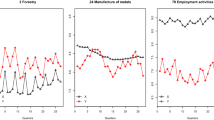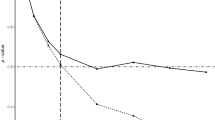Abstract
One of the main problems in empirical sciences is the uncertainty about the relevance of variables. In the debate on the variables that provide a systematic and robust explanation of the share of employees that are members of trade unions, i.e. of trade union density, the problem of variable uncertainty is striking. In regression analyses there is the problem of having to select variables. One problem in the union density discussion is that depending on the chosen combination of regressors different results in the identification of relevant variables are achieved. To systematically analyze which variables are relevant the literature suggests model averaging and selection strategies. While the two strategies have advantages and disadvantages, the aim of this paper is to apply both. Based on a characteristic cross-country panel data set we find differences and similarities based on our evaluation and ask whether a methodological triangulation is possible.
Similar content being viewed by others
References
Ashenfelter O, Pencavel JH (1969) American trade union growth: 1900–1960. Q J Econ 83: 434–448
Blaschke S (2000) Union density and European integration: diverging convergence. Eur J Ind Rel 6: 217– 236
Buckland ST, Burnham KP, Augustin NH (1997) Model selection—an integral part of inference. Biom 53: 275–290
Burnham KP, Anderson DR (2002) Model selection and multimodel inference: a practical information-theoretic approach. Springer, New York
Calmfors L, Booth A, Burda M, Checchi D, Naylor R, Visser J (2001) The future of collective bargaining in Europe. In: Boeri T, Brugiavini A, Calmfors L (eds) The role of unions in the twenty-first century. Oxford University Press, Oxford pp 1–155
Clyde M (1999) Bayesian model averaging and model search strategies. Bayesian Stat 6: 157–185
Clyde M, Desimone H, Parmigiani G (1996) Prediction via orthogonalized model mixing. J Am Stat Assoc 91: 1197–1208
Ebbinghaus B, Visser J (1999) When institutions matter. Eur Soc Rev 15: 135–158
George EI, McCulloch RE (1997) Approaches for Bayesian variable selection. Stat Sin 7: 339–373
Hoeting JA, Madigan D, Raferty AE, Volinsky CT (1999) Bayesian model averaging—a tutorial. Stat Sci 14: 382–417
Hoover KD, Perez SJ (2000) Truth and robustness in cross-country growth regressions. Mimeo, University of California at Davis
Oskarsson S (2003) Institutional explanations of union strength: an assessment. Polit Soc 31: 609–635
Raftery AE, Madigan D, Hoeting JA (1997) Bayesian model averaging for linear regression models. J Am Stat Assoc 92: 179–191
Riley NM (1997) Determinants of union membership: a review. Labour 11: 265–301
Sala-i-Martin X, Doppelhofer G, Miller RI (2004) Determinants of long-term growth: a Bayesian averaging of classical estimates (BACE) approach. Am Eco Rev 94: 813–835
Schnabel C (2003) Determinants of trade union membership. In: Addison JT, Schnabel C (eds) International handbook of trade unions. Edward Elgar, Cheltenham, pp 13–43
Schwarz G (1978) Estimating the dimensions of a model. Ann Stat 6: 461–464
Temple J (2000) Growth regressions and what the textbooks don’t tell you. Bull Econ Res 52: 181–205
Traxler F, Kittel B, Blaschke S (2001) National labour relations in internationalized markets. Oxford University Press, Oxford
Wasserman L (1997) Bayesian model selection and model averaging. Paper presented at the mathematical psychology symposium on methods for model selection 1997, Bloomington, Indiana
Author information
Authors and Affiliations
Corresponding author
Rights and permissions
About this article
Cite this article
Brandl, B. Bayesian model averaging and model selection: two sides of the same coin when identifying the determinants of trade union density?. Cent Eur J Oper Res 17, 13–29 (2009). https://doi.org/10.1007/s10100-008-0072-0
Published:
Issue Date:
DOI: https://doi.org/10.1007/s10100-008-0072-0




